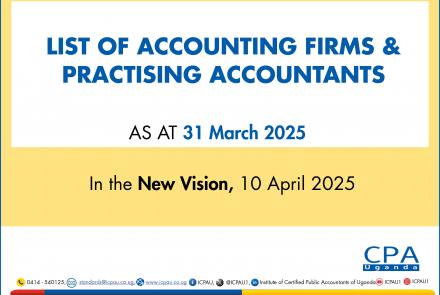By CPA John Sebuuma
The employment law governs the relationship between an employer and an employee and their various rights and duties. It is therefore essential to be able to identify an employee and differentiate them from a self-employed worker sometimes called an independent contractor.
An employee is defined under the Employment Act[1] as any person who has entered into a contract of service or an apprenticeship contract including, without limitation, any person who is employed by or for the Government of Uganda, including the Public Service, a local authority or parastatal organisation but excludes a member of the Uganda Peoples’ Defence Forces.
An independent contractor on the other hand is defined as one who is entrusted to undertake a specific project but who is left free to do the assigned work and to choose the method for accomplishing it[2].
A contract of employment can be categorized into a contract of service and a contract for service. A contract of service is defined as any contract whether oral or written, whether express or implied, where a person agrees in return for remuneration, to work for an employer and includes a contract of apprenticeship[3].
A contract of apprenticeship[4] is defined as a contract of service where an employer ensures that an employee is taught and acquires knowledge and skills of a given industry.
A contract for service is where an employer contracts another to perform a specific duty where the contractor is so specialized and possessed with such skill and resources to perform the work for the employer and not ordinarily subject him or her to direction, control and supervision. A contract of service does not apply to[5];
- employers who employ less than five dependent relatives where they are the only employees;
- the Uganda Peoples’ Defence Forces (UDPF) except the civilian employees.
CRITERIA USED IN DISTINGUISHING A CONTRACT OF SERVICE FROM A CONTRACT FOR SERVICE
Control test: Here the servant is a person who is subject to the command of his master as the manner in which he shall do his work[6]. The employer has exclusive powers to decide the thing to be done, the way in which it shall be done, the means to be employed in doing it, the time when and the place where it shall be done[7].
Integration or organizational test: Under a contract of service, a person is employed as part of the business whereas under a contract for service, his work although done for the business is one not integrated into but a mere accessory to it[8].
Economic test: Here we answer the following questions[9];
- Does the servant agree to provide work in consideration for remuneration?
- Does the servant agree whether expressly or impliedly to be the subject to the other control with sufficient degree to make the other master?
- Are the other provisions of the contract consistent with it being with a contract of service?
Multiple test: This approach suggests that a single test is not conducive and it's always necessary to weigh all the factors in a particular case for instance and three conditions are necessary to establish whether a contract of service exists[10];
- the employee agree that in consideration of wage or other remuneration he will provide his own skill in the performance of some service for his employer
- there must be some element of control exercisable by the employer.
- the other terms of the contract must not be inconsistent with the existence of the contract of employment.
RELEVANCE OF DISTINGUISHING A CONTRACT OF SERVICE AND CONTRACT FOR SERVICE
Vicarious liability: The principle of vicarious liability imposes liability on the employer for the tortious acts committed by his servants during the course of employment[11].
NSSF Act: It is mandatory for employers to make contributions to the fund on behalf of employees[12] i.e. 10% employers contribution and 5% employees contribution.
Workers Compensation Act: Under the Act it is mandatory to compensate an employee who has sustained injuries in the course of employment[13].
Income tax Act: Employees’ employment income is subject to income tax (PAYE)[14] under the Act and independent contractors are subject to withholding tax[15].
Employees also enjoy tax benefits and exemptions under the ITA reimbursement or discharge of the employees medical expenses, benefits during the month where the total value is less than UGX10,000 among other exemptions[16].
VAT Act: It is a requirement for self-employed persons or independent contractors to register, furnish returns and pay VAT[17].
In addition, the supply of services by a foreign person for consideration as part of the person’s business activities is treated as a taxable supply if the services are considered as taking place in Uganda in regards to the place of supply of services[18]..
Employment legislation: Laws and regulations such as the Employment Act, The Labour Union Act, Occupational Safety & Health Act, The Workers Compensation Act only apply to employees and not independent contractors thus rights and benefits such as sick pay, maternity leave, annual leave will only apply to employees.
RECENT TAX DECISIONS IN UGANDA
- International Food Policy Research Institute v Uganda Revenue Authority[19]:
The applicant, a research-based organisation, entered into short-term field office service agreements with various individuals to collect data on various aspects of the applicant’s business. The applicant treated these individuals as independent contractors and withheld 6% tax on all their payments.
The issue of determination by the Tax Appeals Tribunal was whether the said individuals were employees or independent contractors in respect to the organisation.
The Tribunal emphasized the element of control in determining whether a person is an employee of an independent contractor. Based on the interpretation of employment in accordance with the Income Tax Act[20], it includes a position entitling the holder to a fixed or ascertainable remuneration which may not be the case under the Employment Act.
The Tribunal ruled that a person who receives remuneration for a period ranging between five to thirty-five days is short to form the basis to conclude that they obtained a fixed and ascertainable income and thus cannot be considered as employees of the Applicant.
- Infectious Diseases Institute v Uganda Revenue Authority[21]
This was an appeal against the TAT decision by the Appellant, an infectious diseases research-based company also providing medical assistance to patients suffering from contagious diseases in Uganda. The appellant hired specialists to provide specialized research projects and hired them on more than one project at a time.
The Appellant deducted 6% withholding tax and remitted the same to the URA. The URA Conducted a tax compliance audit on the Appellant resulting in an assessment of UGX1,927,442,716 which comprised PAYE of UGX1,776,978,357 and WHT of UGX150,464,359 which the Appellant contended on the basis that the URA was regarding consultants, trainers, volunteers and directors as employees.
The Appellant appealed on the grounds that;
- TAT misapplied the principles in the interpretation of employment under the ITA[22].
- TAT misapplied the principles/tests for determining the existence of the employment relationship.
- TAT failed to evaluate the Applicant’s evidence in its application.
The High Court applied the principles in determining whether one is an employee or otherwise as discussed below;
- Agreement to provide labour in exchange of a wage: Consultants didn't agree to provide labour for a wage - they were paid when either utilized or when they delivered.
- Agreement that the employee will be subject to a sufficient degree of control: The only control the Appellant exercised was contractual - for ensuring that the consultants deliver what has been contractually agreed to be delivered rather than the overarching control in the employment sense.
- The other terms/incidents of the relationship are consistent with employment: The rest of the relationship between the taxpayer and the consultants was not consistent with an employment relationship - payments to consultants were uncertain because they were based on work done or delivery, they were not entitled to leave, no bereavement or sick pay, no cover for injury during course of work and no entitlement to other benefits typical of an employment relationship.
The High Court held that the taxpayer succeeded on all three grounds of appeal based on the above three tests. HC further made an observation of the URA classifying the contracts as employment contracts for purposes of enhancing tax collection efforts which the High Court did not allow because there was no tax due and wouldn't allow an improper collection of tax against a taxpayer.
[1] Section 2 Employment Act Cap. 226
[2] The Black’s Law Dictionary 8th Edition page 888
[3] Section 2 Employment Act Cap. 226
[4] abid
[5] Section 1(1) Employment Act Cap. 226
[6] Yewens v Noakes (1880) 6 QBD 530
[7] Ready Mixed Concrete Ltd v Minister of Pensions & National Insurance [1968] 2 QB 497
[8] Cassidy v Ministry of Health [1951] 2 KB 343
[9] Ready Mixed Concrete Ltd v Minister of Pensions & National Insurance [1968] 2 QB 497
[10]ibid
[11] Section 3(1) Government Proceedings Act, Cap. 287
[12] Section 7 National Social Security Fund Act Cap. 230.
[13] Section 3(1) The Workers Compensation Act, Cap. 233
[14] Section 126 Income Tax Act, Cap. 338
[15] Section 129 Income Tax Act, Cap. 338
[16] Section 19(2) Income Tax Act, Cap. 338
[17] Section 7 Valued Added Tax Act, Cap. 344
[18] Section 18(9) Value Added Tax Act, Cap. 344
[19] Tax Application No. 59 of 2023
[20] Section 2 Income Tax Act, Cap 338
[21] [2024] UGCommC 319
[22] Section 2 Income Tax Act, Cap. 338



